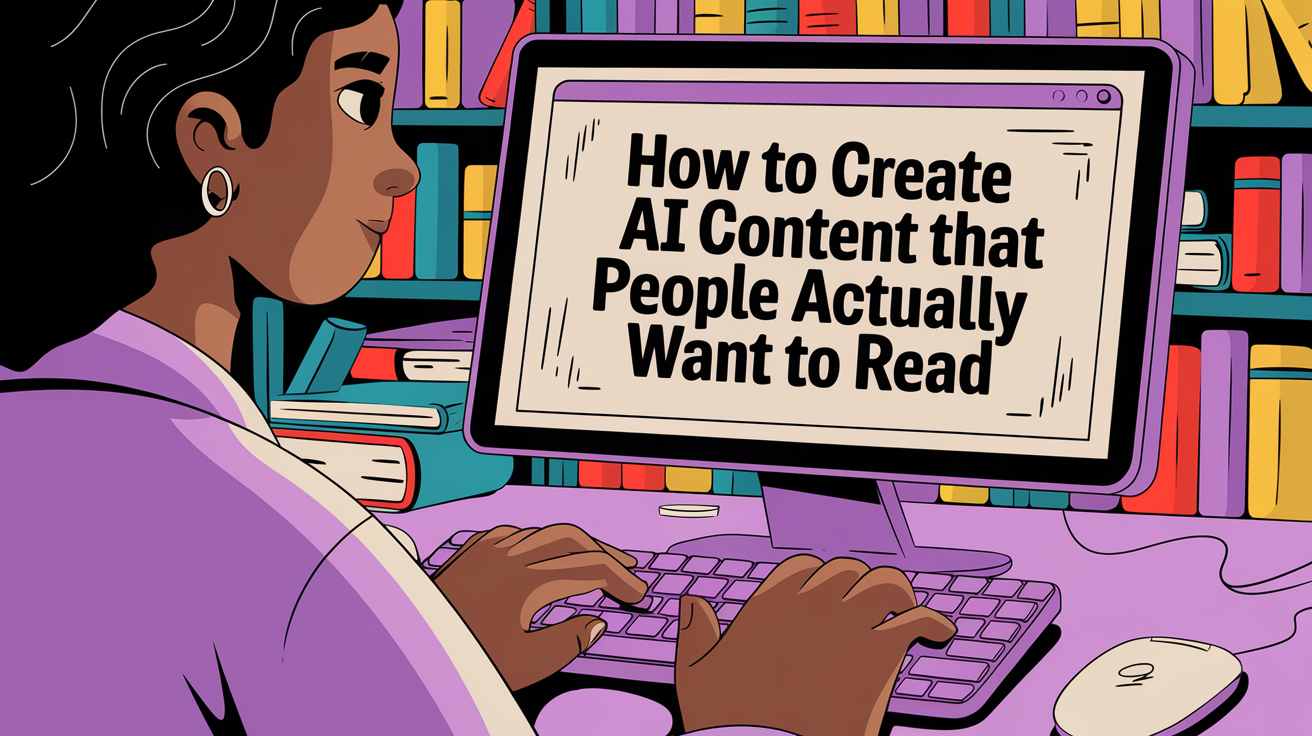How to Create AI Content That People Actually Want to Read
Learn the three-pillar framework for transforming AI from a disappointing experiment into your secret content weapon that readers actually engage with, share, and find valuable.

Why Most AI Content Fails (And How to Make It Remarkable)
Most AI content today feels soulless and generic—churned out by marketers who prioritize quantity over quality. If you've wasted time reading AI-generated articles that promised insights but delivered fluff, you know exactly how frustrating this can be.
The good news? There's a proven framework to transform AI from a disappointing experiment into your secret content weapon. By combining strategic human input with advanced AI capabilities, you can create content that not only ranks well but genuinely helps your audience solve real problems.
In this guide, I'll show you the exact system I've developed for creating AI content that readers actually engage with, share, and—most importantly—find valuable enough to take action on.
Why Most AI Content Fails Miserably
The problem isn't the technology—it's how people use it. After helping dozens of businesses implement AI content strategies, I've seen the same mistakes repeated endlessly:
The "Prompt and Pray" Approach
Many content creators treat AI like a magic wand. They type a vague request, hit generate, and hope for the best. The result? Generic content that reads like it was pulled from a content farm circa 2010.
Here's what actually happens: The AI has no real understanding of your business, your audience, or your unique value proposition. Instead, it generates a bland amalgamation of everything it's seen on the topic—creating the content equivalent of elevator music.
The "Facts? What Facts?" Problem
Standard AI models write confidently, even when they're completely wrong. Without proper guidance, they'll invent statistics, reference non-existent studies, and make claims that could damage your credibility.
One client came to me after publishing an AI-generated article that confidently cited a Harvard study—which turned out to never have existed. Their industry peers noticed, and the reputational damage was significant.
The "Everyone's Already Read This" Effect
Without fresh perspectives or original insights, AI content often rehashes the same basic information available on thousands of other websites. Readers quickly recognize this content for what it is—filler that wastes their time without delivering value.
The Three Pillars of Exceptional AI Content
Creating AI content worth reading isn't about finding the perfect prompt or the newest model—it's about building a systematic approach that leverages AI's strengths while compensating for its weaknesses.
Pillar 1: Inject Real-World Experience
AI has processed billions of text documents but hasn't lived a single day in the real world. This experiential gap creates content that feels theoretical rather than practical.
How to fix it:
Begin every content project by documenting your genuine insights:
- Specific challenges you've encountered
- Solutions that worked (and those that didn't)
- Unusual observations from your experience
- Counter-intuitive lessons you've learned
Even just 5-10 bullet points of original thinking will dramatically transform the quality of your AI-generated content.
One financial advisor I worked with spent just 15 minutes recording voice notes about common client misconceptions. These brief recordings provided enough real-world wisdom to generate a month's worth of uniquely valuable content that outperformed everything they'd published previously.
Pillar 2: Implement Deep Research Capabilities
Standard AI writing involves a model writing from its training data. Deep research-powered content takes a fundamentally different approach by actively seeking current, relevant information.
How to implement it:
- Use AI research tools that can search and analyze hundreds of sources
- Configure your system to extract key insights and data points
- Ensure your tools verify information across multiple sources
- Create feedback loops where research informs further queries
This process mirrors what an exceptional researcher would do, but at scale and speed that's simply not humanly possible.
A SaaS company I consulted with implemented this approach for their blog. Within three months, their organic traffic increased by 87% as their content transformed from basic overviews to genuinely insightful analysis backed by current data.
Pillar 3: Focus on Complete Generation
The latest AI models can generate comprehensive, long-form content in a single pass—avoiding the fragmentation issues of piecing together multiple generations.
Why this matters:
- Creates consistent tone and style throughout
- Ensures logical flow from beginning to end
- Prevents repetition and contradiction
- Allows for natural transitions between sections
When combined with your original insights and deep research, complete generation creates remarkably cohesive content that feels purposeful and considered.
Implementation: Your Step-by-Step AI Content System
Understanding the principles is important, but execution is everything. Here's how to build an AI content system that consistently produces exceptional results.
Step 1: Start With Purpose, Not Technology
Before touching an AI tool, answer these critical questions:
- What specific problem is this content solving for my audience?
- What unique perspective can I bring to this topic?
- How will readers be different after consuming this content?
- What action do I want readers to take afterward?
Document these answers clearly—they become the foundation for everything that follows.
Step 2: Create a Structured Input Template
Develop a consistent template for feeding your AI system that includes:
- Your core expertise and unique angle
- Real examples from your experience
- Specific audience pain points
- Key points that must be included
- Tone and style guidance
- Facts, statistics, and references to incorporate
The structure of your input directly determines the quality of your output. Random instructions produce random results; thoughtful, organized input creates cohesive content.
Step 3: Choose the Right AI Tools
Not all AI tools are created equal. Look for systems that offer:
- Extended context windows (minimum 32k tokens)
- Research capabilities or integrations
- Fact-checking functionality
- Content refinement features
- Brand voice customization
Current leaders for content creation include specialized platforms built on top of models like Claude 3.7 Sonnet that incorporate both writing and research capabilities.
Step 4: Implement a Quality Control Process
Even the best AI systems require human oversight. Create a streamlined review process:
- Verify all factual claims and statistics
- Ensure the content delivers on its promised value
- Check for logical flow and narrative coherence
- Confirm the unique perspective comes through clearly
- Review for brand voice consistency
This quality control step typically takes 15-30 minutes but makes the difference between forgettable content and standout pieces that build authority.
Beyond the Basics: Advanced AI Content Strategies
Once you've mastered the fundamentals, these advanced strategies can take your content to the next level:
Content Ecosystem Planning
Rather than creating isolated pieces, use AI to map comprehensive content ecosystems:
- Identify core topics relevant to your audience
- Map subtopics and related questions
- Plan content that addresses the entire journey
- Create interconnected pieces that guide readers deeper
This approach creates a powerful network effect where each piece strengthens the others.
Personalization at Scale
Use AI to adapt core content for different audience segments:
- Customize examples for specific industries
- Adjust technical depth based on audience expertise
- Create multiple introductions for different reader motivations
- Develop varied call-to-action approaches
This targeted approach significantly increases engagement while leveraging the efficiency of AI.
Conversation Mining for Content Ideas
Your existing customer interactions contain goldmines of content opportunities:
- Use AI to analyze customer questions and conversations
- Identify patterns and recurring themes
- Prioritize topics based on frequency and business impact
- Create content that directly addresses these discovered needs
This strategy ensures your content answers real questions your audience is actually asking.
The Future of AI Content Creation
The landscape of AI content is evolving rapidly. Here's what's on the horizon:
- Increasingly specialized AI models trained for specific content niches
- Better integration between research tools and content generators
- Advanced fact-checking capabilities built into generation systems
- Improved handling of brand voice and style consistency
For businesses that master AI content creation now, the competitive advantage will only grow as these technologies mature.
Taking the Next Step
Creating AI content that people actually want to read isn't about replacing human insight—it's about amplifying it. When you combine your unique expertise with AI's capabilities, you create something neither could achieve alone.
The most successful approach doesn't view AI as a shortcut but as a partnership that leverages the best of both human creativity and machine efficiency.
Ready to transform your content approach? Start by documenting your own insights on your next topic before turning to AI. This simple shift in perspective changes everything.
Continue Reading

How to Use Claude AI to Transform Your Small Business's Digital Presence
Leverage Claude AI to transform your small business online with professional content, competitor analysis, and interactive elements—without the hefty price tag.

Website Speed Optimization That Drives Revenue Growth
Learn which speed optimizations truly impact your bottom line and how to implement them in order of highest ROI to transform user experience and boost conversions.

Don't Sweat the Small Stuff
A simple paperweight taught me to stop chasing noise, conserve energy, and win with calm—at work and in life.
